Effects of Oregano on Lactation Performance, Nutrient Digestibility, Ruminal Fermentation Parameters, and Methane Emissions in Dairy Cows: A Meta-Analysis
Abstract
1. Introduction
2. Materials and Methods
2.1. Literature Search
2.2. Inclusion and Exclusion Criteria
2.3. Data Extraction
2.4. Statistical Analysis
3. Results
3.1. Characteristics of the Database
3.2. Dry Matter Intake, Milk Yield, and Milk Components
3.3. Nutrient Digestibility
3.4. Rumen Fermentation Parameters
3.5. Methane Production
4. Discussion
5. Conclusions
Author Contributions
Funding
Data Availability Statement
Conflicts of Interest
Appendix A
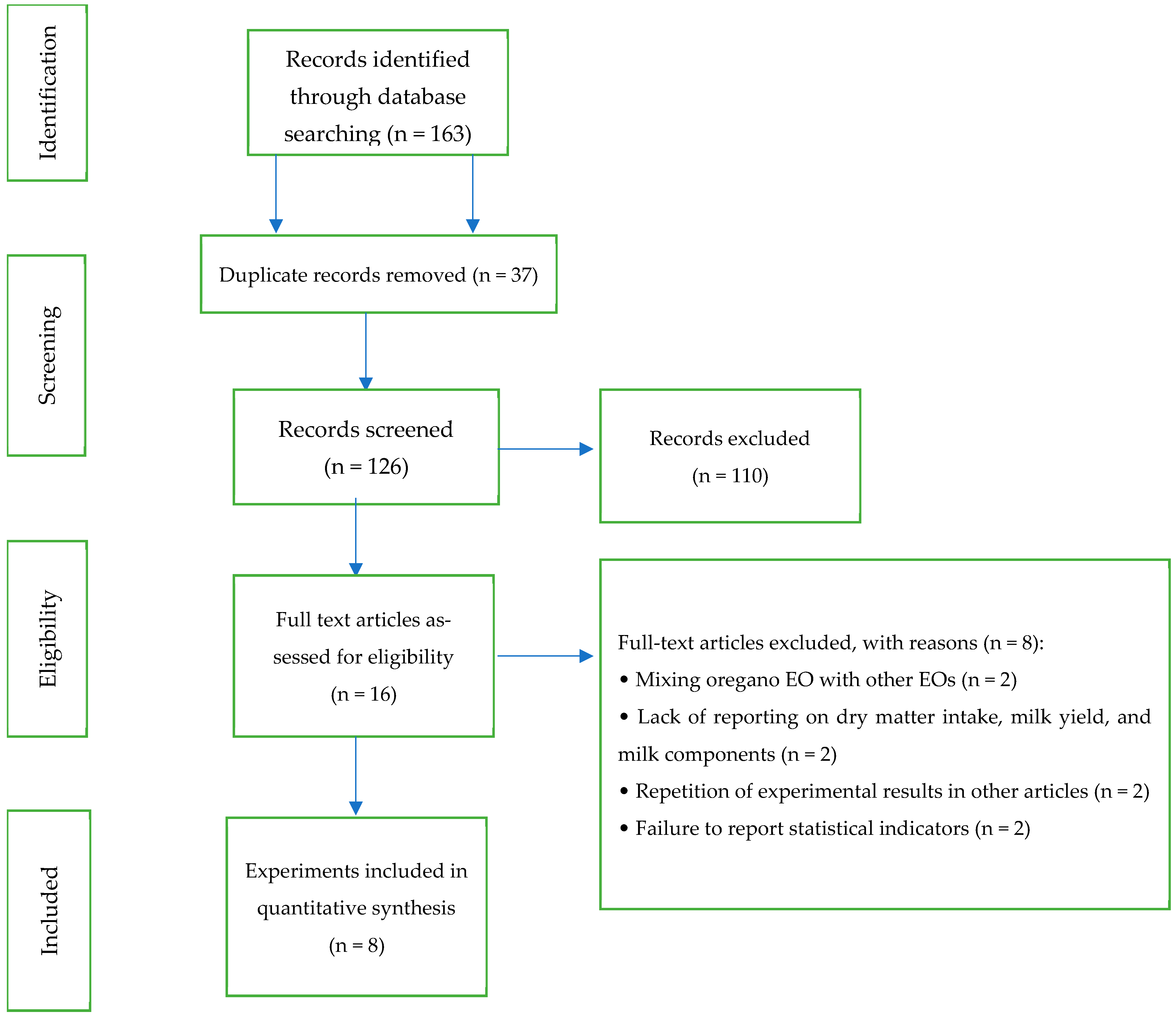
| Reference | Evaluated Variables a |
|---|---|
| Benchaar, 2020 [6] | DMI, MY, MFP, MPP, MLP, DMD, CPD, NDFD, pH, total VFAs, acetate, propionate, butyrate, CH4, CH4/DMI |
| Hristov et al., 2013 [8] | DMI, MY, MFP, MPP, MLP, DMD, CPD, NDFD, pH, total VFAs, acetate, propionate, butyrate, CH4, CH4/DMI |
| Kolling et al., 2018 [12] | DMI, MY, MFP, MLP, CPD, NDFD, pH, total VFAs, acetate, propionate, butyrate, CH4, CH4/DMI |
| Lejonklev et al., 2016 [7] | DMI, MY, MFP, MPP, CH4, CH4/DMI |
| Olijhoek et al., 2019 [9] (Exp. 1) | DMI, MY, MFP, MPP, MLP, DMD, CPD, NDFD, pH, total VFAs, acetate, propionate, butyrate, CH4, CH4/DMI |
| Olijhoek et al., 2019 [9] (Exp. 2) | DMI, MY, MFP, MPP, MLP, DMD, CPD, NDFD, pH, total VFAs, acetate, propionate, butyrate, CH4, CH4/DMI |
| Stefenoni et al., 2021 [13] | DMI, MY, MFP, MPP, MLP, DMD, CPD, NDFD, pH, total VFAs, acetate, propionate, butyrate, CH4, CH4/DMI |
| Stivanin et al., 2019 [14] | DMI, MY |
| Tekippe et al., 2011 [15] | DMI, MY, MFP, MPP, MLP, DMD, CPD, NDFD, pH, total VFAs, acetate, propionate, butyrate, CH4 |

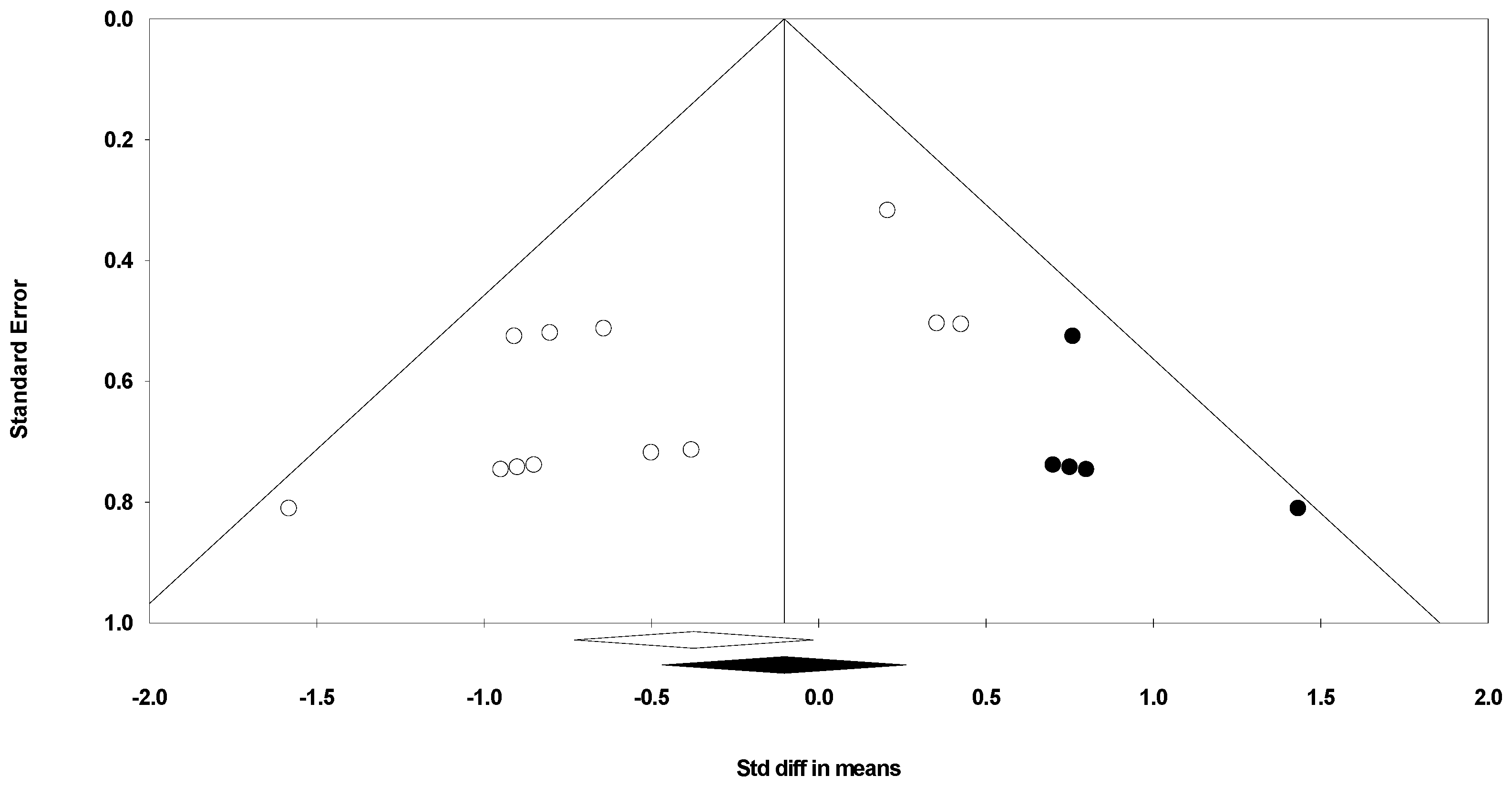
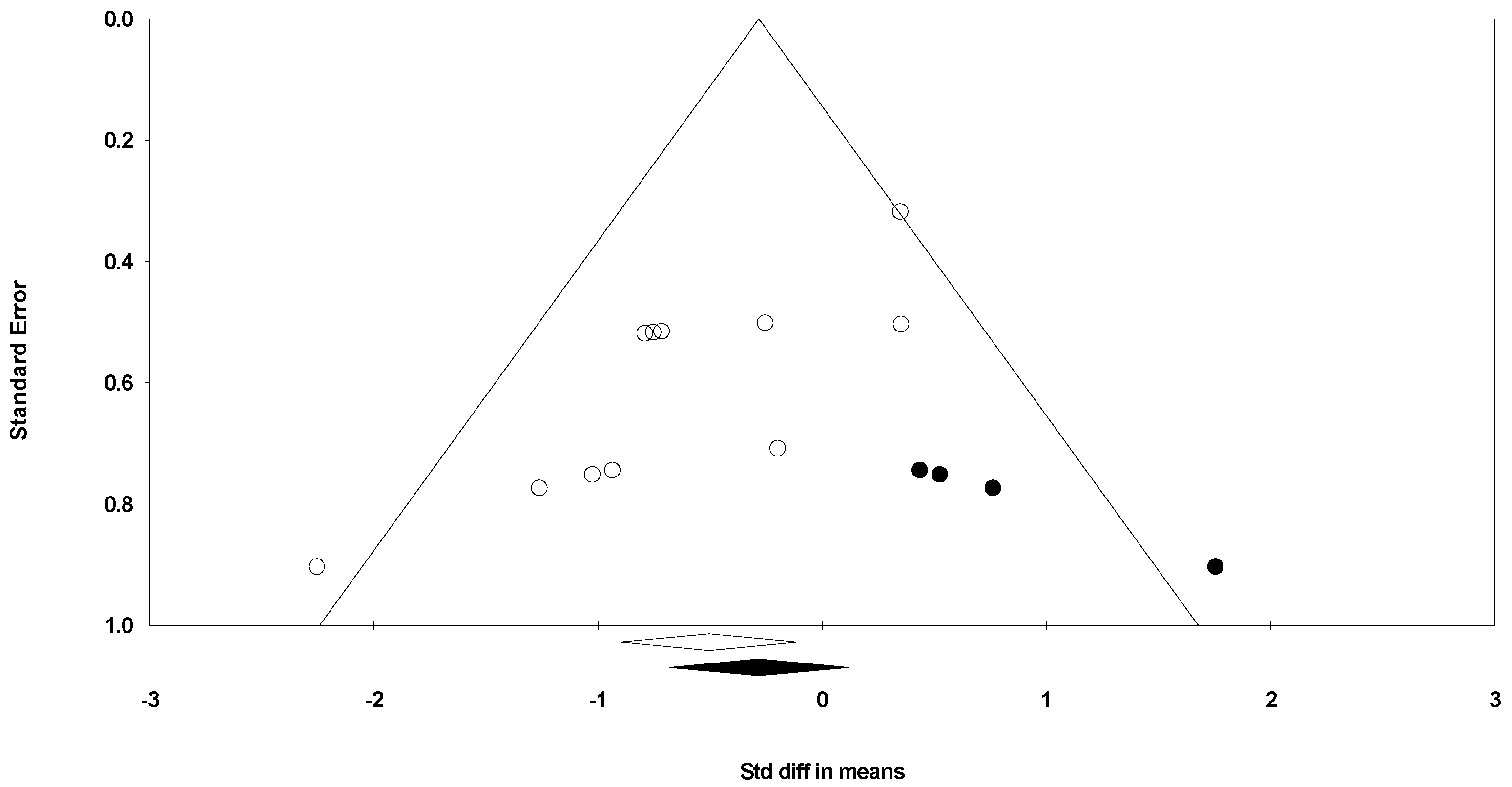

References
- Benchaar, C.; Calsamiglia, S.; Chaves, A.V.; Fraser, G.; Colombatto, D.; McAllister, T.A.; Beauchemin, K.A. A review of plant-derived essential oils in ruminant nutrition and production. Anim. Feed Sci. Technol. 2008, 145, 209–228. [Google Scholar] [CrossRef]
- Calsamiglia, S.; Busquet, M.; Cardozo, P.; Castillejos, L.; Ferret, A. Invited review: Essential oils as modifiers of rumen microbial fermentation. J. Dairy Sci. 2007, 90, 2580–2595. [Google Scholar] [CrossRef]
- Luo, Z.; Liu, T.; Cairang, D.; Cheng, S.; Hu, J.; Shi, B.; Zhu, H.; Chen, H.; Zhang, T.; Yi, X. Oregano Essential Oil as a Natural Plant Additive Affects Growth Performance and Serum Antibody Levels by Regulating the Rumen Microbiota of Calves. Animals 2024, 14, 820. [Google Scholar] [CrossRef] [PubMed]
- Rodriguez-Garcia, I.; Silva-Espinoza, B.; Ortega-Ramirez, L.; Leyva, J.; Siddiqui, M.; Cruz-Valenzuela, M.; Gonzalez-Aguilar, G.; Ayala-Zavala, J. Oregano essential oil as an antimicrobial and antioxidant additive in food products. Crit. Rev. Food Sci. Nutr. 2016, 56, 1717–1727. [Google Scholar] [CrossRef] [PubMed]
- Zhou, R.; Wu, J.; Lang, X.; Liu, L.; Casper, D.P.; Wang, C.; Zhang, L.; Wei, S. Effects of oregano essential oil on in vitro ruminal fermentation, methane production, and ruminal microbial community. J. Dairy Sci. 2020, 103, 2303–2314. [Google Scholar] [CrossRef]
- Benchaar, C. Feeding oregano oil and its main component carvacrol does not affect ruminal fermentation, nutrient utilization, methane emissions, milk production, or milk fatty acid composition of dairy cows. J. Dairy Sci. 2020, 103, 1516–1527. [Google Scholar] [CrossRef]
- Lejonklev, J.; Kidmose, U.; Jensen, S.; Petersen, M.; Helwing, A.; Mortensen, G.; Weisbjerg, M.R.; Larsen, M.K. Effect of oregano and caraway essential oils on the production and flavor of cow milk. J. Dairy Sci. 2016, 99, 7898–7903. [Google Scholar] [CrossRef]
- Hristov, A.; Lee, C.; Cassidy, T.; Heyler, K.; Tekippe, J.; Varga, G.; Corl, B.; Brandt, R. Effect of Origanum vulgare L. leaves on rumen fermentation, production, and milk fatty acid composition in lactating dairy cows. J. Dairy Sci. 2013, 96, 1189–1202. [Google Scholar] [CrossRef]
- Olijhoek, D.; Hellwing, A.L.F.; Grevsen, K.; Haveman, L.; Chowdhury, M.R.; Løvendahl, P.; Weisbjerg, M.R.; Noel, S.J.; Højberg, O.; Wiking, L. Effect of dried oregano (Origanum vulgare L.) plant material in feed on methane production, rumen fermentation, nutrient digestibility, and milk fatty acid composition in dairy cows. J. Dairy Sci. 2019, 102, 9902–9918. [Google Scholar] [CrossRef]
- Sutton, A.J.; Higgins, J.P. Recent developments in meta-analysis. Stat. Med. 2008, 27, 625–650. [Google Scholar] [CrossRef]
- Moher, D.; Liberati, A.; Tetzlaff, J.; Altman, D.G.; The PRISMA Group. Preferred reporting items for systematic reviews and meta-analyses: The PRISMA statement. Ann. Intern. Med. 2009, 151, 264–269. [Google Scholar] [CrossRef] [PubMed]
- Kolling, G.; Stivanin, S.; Gabbi, A.; Machado, F.; Ferreira, A.; Campos, M.; Tomich, T.; Cunha, C.; Dill, S.; Pereira, L. Performance and methane emissions in dairy cows fed oregano and green tea extracts as feed additives. J. Dairy Sci. 2018, 101, 4221–4234. [Google Scholar] [CrossRef] [PubMed]
- Stefenoni, H.; Räisänen, S.; Cueva, S.; Wasson, D.E.; Lage, C.; Melgar, A.; Fetter, M.; Smith, P.; Hennessy, M.; Vecchiarelli, B. Effects of the macroalga Asparagopsis taxiformis and oregano leaves on methane emission, rumen fermentation, and lactational performance of dairy cows. J. Dairy Sci. 2021, 104, 4157–4173. [Google Scholar] [CrossRef] [PubMed]
- Stivanin, S.C.B.; Vizzotto, E.F.; de Paris, M.; Zanela, M.B.; Passos, L.T.; Angelo, I.D.V.; Fischer, V. Addition of oregano or green tea extracts into the diet for Jersey cows in transition period. Feeding and social behavior, intake and health status. Plant extracts for cows in the transition period. Anim. Feed Sci. Technol. 2019, 257, 114265. [Google Scholar] [CrossRef]
- Tekippe, J.; Hristov, A.; Heyler, K.; Cassidy, T.; Zheljazkov, V.; Ferreira, J.; Karnati, S.; Varga, G. Rumen fermentation and production effects of Origanum vulgare L. leaves in lactating dairy cows. J. Dairy Sci. 2011, 94, 5065–5079. [Google Scholar] [CrossRef]
- Borenstein, M.; Hedges, L.V.; Higgins, J.; Rothstein, H.R. Introduction to Meta-Analysis; Wiley Online Library: Hoboken, NJ, USA, 2009. [Google Scholar]
- Lean, I.; Rabiee, A.; Duffield, T.F.; Dohoo, I. Invited review: Use of meta-analysis in animal health and reproduction: Methods and applications. J. Dairy Sci. 2009, 92, 3545–3565. [Google Scholar] [CrossRef]
- Huedo-Medina, T.B.; Sánchez-Meca, J.; Marín-Martínez, F.; Botella, J. Assessing heterogeneity in meta-analysis: Q statistic or I² index? Psychol. Methods 2006, 11, 193. [Google Scholar] [CrossRef]
- Higgins, J.P.; Green, S. Cochrane Handbook for Systematic Reviews of Interventions; Wiley-Blackwell: West Sussex, UK, 2008. [Google Scholar]
- Egger, M.; Smith, G.D.; Schneider, M.; Minder, C. Bias in meta-analysis detected by a simple, graphical test. BMJ 1997, 315, 629–634. [Google Scholar] [CrossRef]
- Duval, S.; Tweedie, R. A nonparametric “trim and fill” method of accounting for publication bias in meta-analysis. J. Am. Stat. Assoc. 2000, 95, 89–98. [Google Scholar]
- Mucha, W.; Witkowska, D. The applicability of essential oils in different stages of production of animal-based foods. Molecules 2021, 26, 3798. [Google Scholar] [CrossRef]
- Al-Suwaiegh, S.B.; Morshedy, S.A.; Mansour, A.T.; Ahmed, M.H.; Zahran, S.M.; Alnemr, T.M.; Sallam, S.M. Effect of an essential oil blend on dairy cow performance during treatment and post-treatment periods. Sustainability 2020, 12, 9123. [Google Scholar] [CrossRef]
- Kholif, A.E.; Olafadehan, O.A. Essential oils and phytogenic feed additives in ruminant diet: Chemistry, ruminal microbiota and fermentation, feed utilization and productive performance. Phytochem. Rev. 2021, 20, 1087–1108. [Google Scholar] [CrossRef]
- Dorantes-Iturbide, G.; Orzuna-Orzuna, J.F.; Lara-Bueno, A.; Mendoza-Martínez, G.D.; Miranda-Romero, L.A.; Lee-Rangel, H.A. Essential oils as a dietary additive for small ruminants: A meta-analysis on performance, rumen parameters, serum metabolites, and product quality. Vet. Sci. 2022, 9, 475. [Google Scholar] [CrossRef] [PubMed]
- Li, S.; Du, M.; Zhang, C.; Wang, Y.; Lee, Y.; Zhang, G. Diet type impacts production performance of fattening lambs by manipulating the ruminal microbiota and metabolome. Front. Microbiol. 2022, 13, 824001. [Google Scholar] [CrossRef]
- Benchaar, C.; Greathead, H. Essential oils and opportunities to mitigate enteric methane emissions from ruminants. Anim. Feed Sci. Technol. 2011, 166, 338–355. [Google Scholar] [CrossRef]
- Lambo, M.; Ma, H.; Liu, R.; Dai, B.; Zhang, Y.; Li, Y. Mechanism, effectiveness, and the prospects of medicinal plants and their bioactive compounds in lowering ruminants’ enteric methane emission. Animal 2024, 18, 101134. [Google Scholar] [CrossRef]
- Zhou, R.; Wu, J.; Zhang, L.; Liu, L.; Casper, D.P.; Jiao, T.; Liu, T.; Wang, J.; Lang, X.; Song, S. Effects of oregano essential oil on the ruminal pH and microbial population of sheep. PLoS ONE 2019, 14, e0217054. [Google Scholar] [CrossRef]
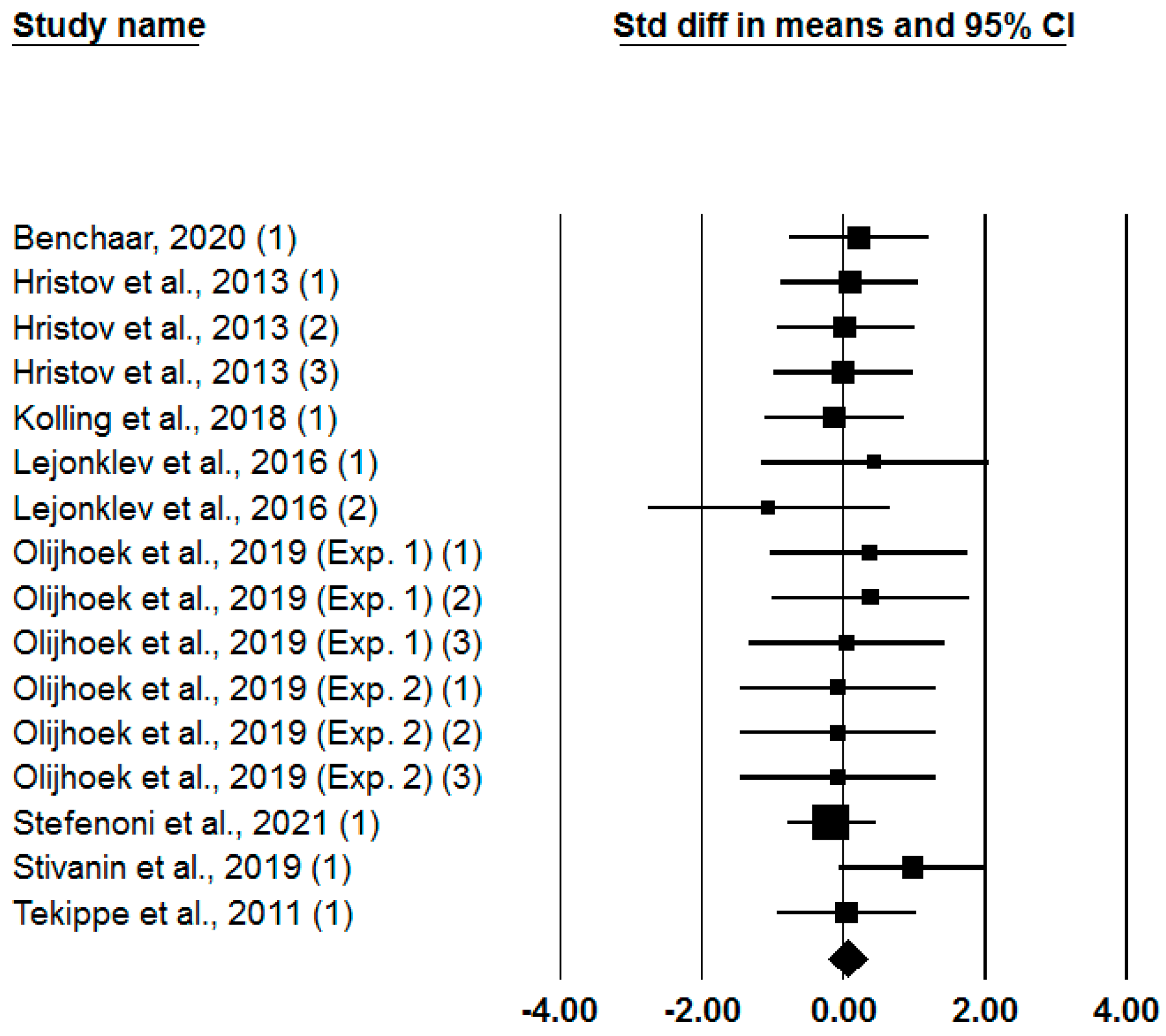
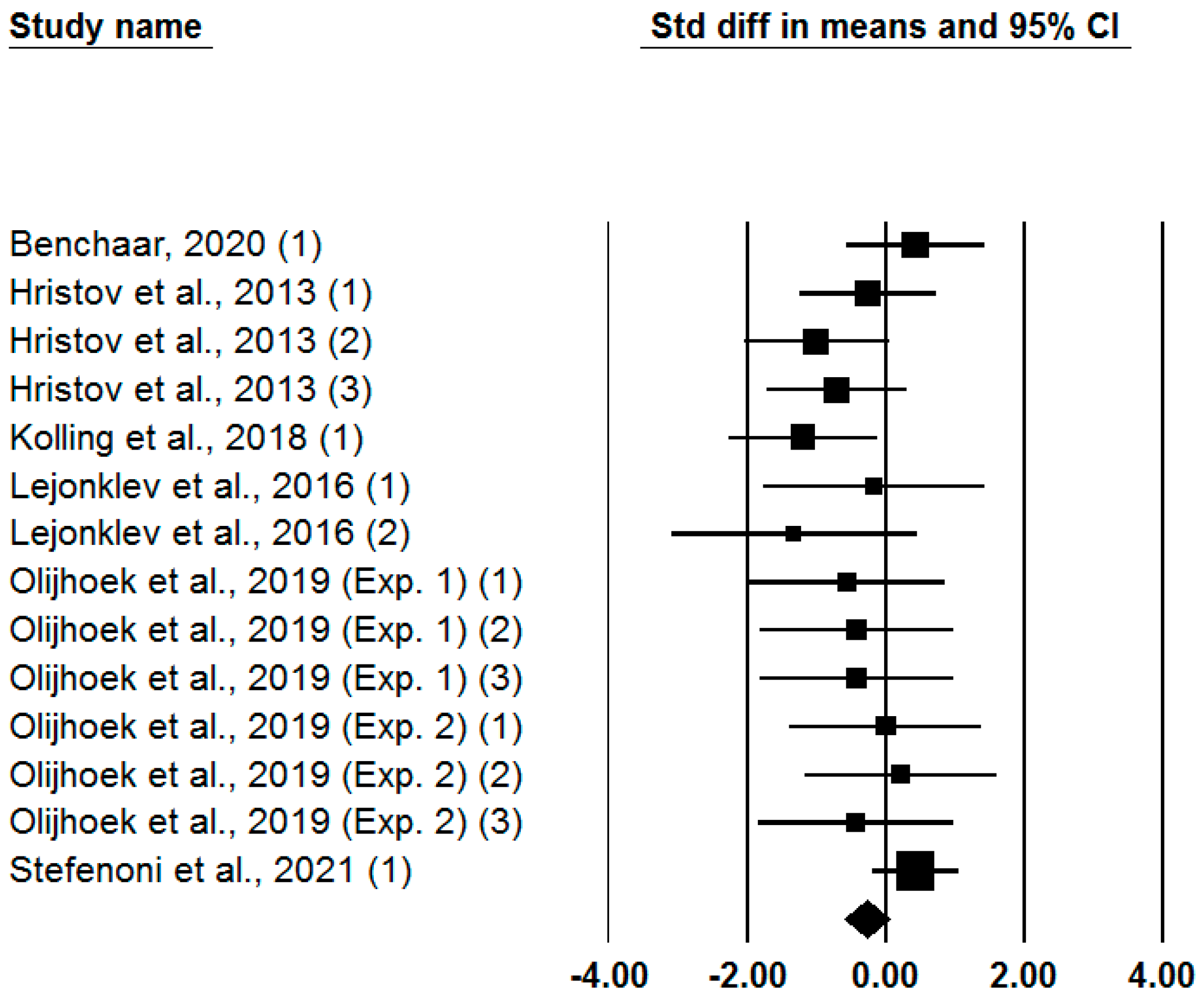
| Reference | CC a | Breed | Forages | Form of Oregano b | Amount of Oregano | Oregano Delivery c | CH4 Measurement Method d |
|---|---|---|---|---|---|---|---|
| Benchaar, 2020 [6] | 1 | - | alfalfa silage and corn silage | EO | 50 mg/kg of DM | TMR | RC |
| Hristov et al., 2013 [8] | 3 | Holstein | corn silage, alfalfa haylage, and grass hay | L | 250 g/d, 500 g/d, 750 g/d | TMR | SF6 |
| Kolling et al., 2018 [12] | 1 | Holstein and Holstein–Gir | corn silage and Tifton hay | EO | 0.056% of DM | TP | RC |
| Lejonklev et al., 2016 [7] | 2 | Danish Holstein | maize silage and grass–clover silage | EO | 0.2 g/kg of DM, 1.0 g/kg of DM | TMR | RC |
| Olijhoek et al., 2019 [9] (Exp. 1) | 3 | Danish Holstein | grass/clover silage and maize silage | PM | 17.8 g/kg DM, 35.5 g/kg DM, 53.3 g/kg DM | TMR | RC |
| Olijhoek et al., 2019 [9] (Exp. 2) | 3 | Danish Holstein | grass/clover silage and maize silage | PM | 7 g/kg DM, 13.9 g/kg DM, 20.9 g/kg DM | TMR | RC |
| Stefenoni et al., 2021 [13] | 1 | Holstein | corn silage, alfalfa haylage, and grass hay | L | 1.77% of DM | TMR | SF6 |
| Stivanin et al., 2019 [14] | 1 | Jersey | corn silage and pasture | EO | 10 g/d | TP | - |
| Tekippe et al., 2011 [15] | 1 | Holstein | corn silage, alfalfa silage, and grass/straw hay | L | 500 g/d | TP | SF6 |
| Outcomes a | CC b | SMD c (95% CI d) | Heterogeneity | RMD e (95% CI) | Publication Bias | |||
|---|---|---|---|---|---|---|---|---|
| Random Effect | p-Value | Q | p-Value | I2 | Random Effect | Egger (p-Value) | ||
| DMI, kg/d | 23 | 0.081 (−0.157, 0.318) | 0.507 | 7.978 | 0.997 | 0.0 | 0.274 (−0.084, 0.631) | 0.298 |
| MY, kg/d | 16 | 0.060 (−0.211, 0.331) | 0.665 | 6.234 | 0.976 | 0.0 | 0.216 (−0.571, 1.002) | 0.746 |
| MFP, % | 15 | −0.054 (−0.338, 0.231) | 0.711 | 11.441 | 0.651 | 0.0 | −0.061 (−0.181, 0.058) | 0.238 |
| MPP, % | 14 | −0.021 (−0.314, 0.271) | 0.886 | 1.410 | 1.00 | 0.0 | 0.009 (−0.037, 0.055) | 0.139 |
| MLP, % | 13 | −0.180 (−0.471, 0.110) | 0.224 | 2.505 | 0.998 | 0.0 | −0.019 (−0.056, 0.017) | 0.721 |
| Outcomes a | CC b | SMD c (95% CI d) | Heterogeneity | RMD e (95% CI) | Publication Bias | |||
|---|---|---|---|---|---|---|---|---|
| Random Effect | p-Value | Q | p-Value | I2 | Random Effect | Egger (p-Value) | ||
| DMD, % | 11 | −0.502 (−0.895, −0.108) | 0.013 | 13.022 | 0.222 | 23.207 | −0.886 (−1.390, −0.382) | <0.1 |
| CPD, % | 12 | −0.374 (−0.730, −0.017) | 0.040 | 13.561 | 0.258 | 18.887 | −0.822 (−1.479, −0.166) | <0.1 |
| NDFD, % | 12 | −0.505 (−0.907, −0.103) | 0.014 | 16.486 | 0.124 | 33.276 | −1.448 (−2.383, −0.513) | <0.1 |
| Outcomes a | CC b | SMD c (95% CI d) | Heterogeneity | RMD e (95% CI) | Publication Bias | |||
|---|---|---|---|---|---|---|---|---|
| Random Effect | p-Value | Q | p-Value | I2 | Random Effect | Egger (p-Value) | ||
| pH | 13 | −0.122 (−0.413, 0.169) | 0.411 | 3.879 | 0.986 | 0.0 | −0.012 (−0.046, 0.023) | 0.161 |
| Total VFAs, mM | 13 | −0.038 (−0.329, 0.253) | 0.798 | 4.615 | 0.970 | 0.0 | −0.863 (−4.313, 2.587) | 0.013 |
| Acetate, mol/100 mol | 13 | −0.046 (−0.336, 0.244) | 0.757 | 3.129 | 0.995 | 0.0 | −0.025 (−0.624, 0.574) | 0.248 |
| Propionate, mol/100 mol | 13 | 0.007 (−0.248, 0.299) | 0.960 | 5.615 | 0.934 | 0.0 | −0.057 (−0.457, 0.343) | 0.109 |
| Butyrate, mol/100 mol | 13 | 0.037 (−0.254, 0.329) | 0.801 | 5.873 | 0.922 | 0.0 | 0.216 (−0.181, 0.613) | 0.123 |
| Outcomes | CC a | SMD b (95% CI c) | Heterogeneity | RMD d (95% CI) | Publication Bias | |||
|---|---|---|---|---|---|---|---|---|
| Random Effect | p-Value | Q | p-Value | I2 | Random Effect | Egger (p-Value) | ||
| CH4, g/d | 15 | −0.156 (−0.441, 0.128) | 0.282 | 11.100 | 0.678 | 0.0 | −2.221 (−16.606, 12.165) | 0.269 |
| CH4/DMI, g/kg | 14 | −0.275 (−0.599, 0.048) | 0.095 | 14.544 | 0.337 | 10.617 | −0.340 (−0.915, 0.236) | 0.101 |
Disclaimer/Publisher’s Note: The statements, opinions and data contained in all publications are solely those of the individual author(s) and contributor(s) and not of MDPI and/or the editor(s). MDPI and/or the editor(s) disclaim responsibility for any injury to people or property resulting from any ideas, methods, instructions or products referred to in the content. |
© 2024 by the authors. Licensee MDPI, Basel, Switzerland. This article is an open access article distributed under the terms and conditions of the Creative Commons Attribution (CC BY) license (https://creativecommons.org/licenses/by/4.0/).
Share and Cite
Mahdavi, A.; Darabighane, B. Effects of Oregano on Lactation Performance, Nutrient Digestibility, Ruminal Fermentation Parameters, and Methane Emissions in Dairy Cows: A Meta-Analysis. Climate 2024, 12, 167. https://doi.org/10.3390/cli12100167
Mahdavi A, Darabighane B. Effects of Oregano on Lactation Performance, Nutrient Digestibility, Ruminal Fermentation Parameters, and Methane Emissions in Dairy Cows: A Meta-Analysis. Climate. 2024; 12(10):167. https://doi.org/10.3390/cli12100167
Chicago/Turabian StyleMahdavi, Ali, and Babak Darabighane. 2024. "Effects of Oregano on Lactation Performance, Nutrient Digestibility, Ruminal Fermentation Parameters, and Methane Emissions in Dairy Cows: A Meta-Analysis" Climate 12, no. 10: 167. https://doi.org/10.3390/cli12100167
APA StyleMahdavi, A., & Darabighane, B. (2024). Effects of Oregano on Lactation Performance, Nutrient Digestibility, Ruminal Fermentation Parameters, and Methane Emissions in Dairy Cows: A Meta-Analysis. Climate, 12(10), 167. https://doi.org/10.3390/cli12100167







